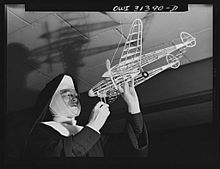Mary Aquinas Kinskey: Difference between revisions
→Biography: appended |
appended entry |
||
| Line 16: | Line 16: | ||
}} |
}} |
||
Sister Mary Aquinas Kinskey, OSF was an expert and teacher of aerodynamics and aviation. |
Sister Mary Aquinas Kinskey, OSF was an expert and teacher of aerodynamics and aviation. She was also an accomplished pilot, an unusual role for a female religious person in her time. |
||
== Biography == |
== Biography == |
||
Revision as of 18:10, 5 November 2015
This article needs additional citations for verification. (November 2015) |
Mary Aquinas Kinskey | |
|---|---|
 | |
| Personal | |
| Born | Mary Aquinas Kinskey May 27, 1894 |
| Died | October 20, 1985 (aged 90–91) |
| Religion | Catholic |
| Nationality | American |
| Organization | |
| Institute | Franciscan |
Sister Mary Aquinas Kinskey, OSF was an expert and teacher of aerodynamics and aviation. She was also an accomplished pilot, an unusual role for a female religious person in her time.
Biography
Mary Kinskey was born in 1894 in Zanesville, Ohio.
She entered a Franciscan convent in 1911 at the age of 17.
She then graduated from the Catholic University of America in 1926 and started work as a high school teacher. According to the Notre Dame Archives and News, “She became a teacher and her interest in aviation stemmed from the enthusiasm for the subject from her students.”
She retired to the Manitowoc convent after suffering a stroke in 1977. There she remained until her death in 1985. [1]
She was referred to as "Spike" and "Flying Nun". The latter moniker caused speculation about her possible influence on the TV show The Flying Nun. [2]
Awards
1957, Special citation from the United States Air Force for her “outstanding contributions to the advancement of air power in the interest of national security and world peace.” [3]
External Links
References
- ^ https://news.google.com/newspapers?nid=1499&dat=19851021&id=Y24aAAAAIBAJ&sjid=VioEAAAAIBAJ&pg=2468,440597&hl=en
- ^ http://www.nytimes.com/1985/10/23/us/sister-mary-aquinas-is-dead-pilot-inspired-tv-flying-nun.html
- ^ http://anunslife.org/blog/nunday/nunday-the-original-flying-nun-sister-mary-aquinas-kinskey-osf
